Experimental Investigation of the Mesostructural Damage in Bedded Rock Salt During Creep Deformation
Abstract
1. Introduction
2. Experimental Methodology
2.1. Experiment Materials
2.2. Experimental Apparatus
2.3. Experimental Procedures
3. Analysis of Experimental Results
3.1. Microstructure and Mineral Composition Analysis of Layered Rock Salt
3.2. Evolution of Creep Deformation
3.3. Evolution of Creep Damage in the Mesostructure
3.3.1. Characteristics of Damage Propagation in the Mesostructure
3.3.2. Mechanism of Mesostructural Damage in Creep Deformation
4. Conclusions
- (1)
- Bedded rock salt and mudstones exhibit significant differences in microstructure, mineral composition, and physical properties. SEM-EDS analyses reveal distinct microstructural variations among rock salt, mudstone, and their interfacial zones. As shown in Table 1, the mineral composition of bedded salt formations demonstrates greater complexity compared to the other two lithologies. Variations in grain size distribution among different mineral components result in well-developed interfacial pores with complex structures and high connectivity.
- (2)
- Microstructural heterogeneity in bedded rock salt induces incompatible creep deformation, generating additional stress fields manifested as intergranular shear damage. When superimposed stresses exceed the tensile strength of interlayers, tensile failure occurs in rock salt. During creep stages with a rate of 0.00047, mineral compaction dominates in impurity zones. As external stress increases, creep rates escalate to 0.00092 to 0.0027, triggering intergranular dislocations that initiate microcracks. These subsequently interact with pre-existing fractures, ultimately coalescing into larger discontinuities.
- (3)
- Strain nephograms demonstrate that deformation in bedded rock salt is primarily governed by salt–mudstone interfaces through shear-dominated failure mechanisms. During primary creep loading, shear strain and volumetric strain distributions reveal localized deformation concentrated in impurity zones. Secondary creep loading induces microcrack initiation at interfacial regions due to deformation incompatibility, with damage progressively propagating into adjacent rock salt. At the accelerated creep stage, dilatancy damage intensifies predominantly in upper strata, where interconnected microcracks in impurity zones coalesce with newly formed fractures.
Author Contributions
Funding
Institutional Review Board Statement
Informed Consent Statement
Data Availability Statement
Acknowledgments
Conflicts of Interest
References
- Song, Y.; Song, R.; Liu, J. Hydrogen tightness evaluation in bedded salt rock cavern: A case study of Jintan, China. Int. J. Hydrogen Energy 2024, 48, 30489–30506. [Google Scholar] [CrossRef]
- Liu, W.; Jiang, D.; Chen, J.; Daemen, J.J.K.; Tang, K. Comprehensive feasibility study of two-well-horizontal caverns for natural gas storage in thinly-bedded salt rocks in China. Energy 2018, 143, 1006–1019. [Google Scholar] [CrossRef]
- Zhang, X.; Liu, W.; Jiang, D.; Qiao, W.; Liu, E.; Zhang, N. Investigation on the influences of interlayer contents on stability and usability of energy storage caverns in bedded rock salt. Energy 2021, 231, 120968. [Google Scholar] [CrossRef]
- Wang, T.; Liao, Y.; Yang, C.; Xie, D.; Chen, W.; Wang, D. Gas transport model in pore heterogeneous bedded salt rock: Implications for tightness evaluation of salt cavern gas storage. Gas Sci. Eng. 2024, 121, 205185. [Google Scholar] [CrossRef]
- Zhang, N.; Liu, W.; Zhang, Y.; Shan, P.; Shi, X. Microscopic pore structure of surrounding rock for underground strategic petroleum reserve (SPR) caverns in bedded rock salt. Energies 2020, 13, 1565. [Google Scholar] [CrossRef]
- Liu, W.; Li, Y.; Yang, C.; Daemen, J.J.; Yang, Y.; Zhang, G. Permeability characteristics of mudstone cap rock and interlayers in bedded salt formations and tightness assessment for underground gas storage caverns. Eng. Geol. 2015, 193, 212–223. [Google Scholar] [CrossRef]
- Houben, M.E.; Barnhoorn, A.; Lie-A-Fat, J.; Ravestein, T.; Peach, C.J.; Drury, M.R. Microstructural characteristics of the Whitby Mudstone formation (UK). Mar. Pet. Geol. 2016, 70, 185–200. [Google Scholar] [CrossRef]
- Thiemeyer, N.; Habersetzer, J.; Peinl, M.; Zulauf, G.; Hammer, J. The application of high resolution X-ray computed tomography on naturally deformed rock salt: Multi-scale investigations of the structural inventory. J. Struct. Geol. 2015, 77, 92–106. [Google Scholar] [CrossRef]
- Teles, A.P.; Machado, A.C.; Pepin, A.; Bize-Forest, N.; Lopes, R.T.; Lima, I. Analysis of subterranean Pre-salt carbonate reservoir by X-ray computed microtomography. J. Pet. Sci. Eng. 2016, 144, 113–120. [Google Scholar] [CrossRef]
- Pavón, E.; Alba, M.D. Swelling layered minerals applications: A solid state NMR overview. Prog. Nucl. Magn. Reson. Spectrosc. 2021, 124, 99–128. [Google Scholar]
- Liang, K.; Xie, L.; He, B.; Zhao, P.; Zhang, Y.; Hu, W. Effects of grain size distributions on the macro-mechanical behavior of rock salt using micro-based multiscale methods. Int. J. Rock Mech. Min. Sci. 2021, 138, 104592. [Google Scholar] [CrossRef]
- Vandeginste, V.; Ji, Y.; Buysschaert, F.; Anoyatis, G. Mineralogy, microstructures and geomechanics of rock salt for underground gas storage. Deep. Undergr. Sci. Eng. 2023, 2, 129–147. [Google Scholar] [CrossRef]
- Liu, Z.; Ma, C.; Wei, X.A. Electron scanning characteristics of rock materials under different loading methods: A review. Geomech. Geophys. Geo-Energy Geo-Resour. 2022, 8, 80. [Google Scholar] [CrossRef]
- Desbois, G.; Urai, J.L.; Kukla, P.A. Morphology of the pore space in claystones–evidence from BIB/FIB ion beam sectioning and cryo-SEM observations. eEarth Discuss. 2009, 4, 1–19. [Google Scholar] [CrossRef]
- Schléder, Z.; Urai, J.L. Microstructural evolution of deformation-modified primary halite from the Middle Triassic Röt Formation at Hengelo, The Netherlands. Int. J. Earth Sci. 2005, 94, 941–955. [Google Scholar] [CrossRef]
- Adamuszek, M.; Tămaș, D.M.; Barabasch, J.; Urai, J.L. Rheological stratification in impure rocksalt during long-term creep: Morphology, microstructure and numerical models of multilayer folds in the Ocnele Mari salt mine, Romania. Solid Earth Discuss. 2021, 2021, 1–40. [Google Scholar]
- Martin-Clave, C.; Ougier-Simonin, A.; Vandeginste, V. Impact of second phase content on rock salt rheological behavior under cyclic mechanical conditions. Rock Mech. Rock Eng. 2021, 54, 1–23. [Google Scholar] [CrossRef]
- He, J.; Li, Y.; Jin, Y.; Wang, A.; Zhang, Y.; Jia, J.; Liang, D. Study on mechanical problems of complex rock mass by composite material micromechanics methods: A literature review. Front. Earth Sci. 2022, 9, 808161. [Google Scholar] [CrossRef]
- Cheng, Y.; Song, Z.; Liu, Z.; Tian, X.; Qian, W.; Lu, X.; Yang, T. Micro-cracking morphology and dynamic fracturing mechanism of natural brittle sandstone containing layer structure under compression. Constr. Build. Mater. 2024, 425, 136051. [Google Scholar] [CrossRef]
- Gelencsér, O.; Szakács, A.; Gál, Á.; Szabó, Á.; Dankházi, Z.; Tóth, T.; Falus, G. Microstructural study of the Praid Salt Diapir (Transylvanian basin, Romania) and its implication on deformation history and hydrogen storage potential. Acta Geod. Geophys. 2024, 59, 343–365. [Google Scholar] [CrossRef]
- Zheng, Z.; Wang, G.; Hu, X.; Niu, C.; Ma, H.; Liao, Y.; Zhao, K.; Zeng, Z.; Li, H.; Yang, C. Microstructural evolution and mechanical behaviors of rock salt in energy storage: A molecular dynamics approach. Int. J. Rock Mech. Min. Sci. 2024, 182, 105882. [Google Scholar] [CrossRef]
- Mansouri, H.; Ajalloeian, R. Mechanical behavior of salt rock under uniaxial compression and creep tests. Int. J. Rock Mech. Min. Sci. 2018, 110, 19–27. [Google Scholar] [CrossRef]
- Khan, T.H.; Myers, M.T.; Hathon, L.; Unomah, G.C. Time-Scaling Creep in Salt Rocks for Underground Storage. Petrophysics- SPWLA J. Form. Eval. Reserv. Descr. 2023, 64, 954–969. [Google Scholar] [CrossRef]
- Gao, R.; Wu, F.; Chen, J.; Zhu, C.; Ji, C. Study on creep characteristics and constitutive model of typical argillaceous salt rock in energy storage caverns in China. J. Energy Storage 2022, 50, 104248. [Google Scholar] [CrossRef]
- Fourmeau, M.; Liu, W.; Li, Z.; Nelias, D.; Fan, J.; Tian, H. Research status of creep–fatigue characteristics of salt rocks and stability of compressed air storage in salt caverns. Earth Energy Sci. 2024, 1, 98–116. [Google Scholar] [CrossRef]
- Lyu, C.; Liu, J.; Ren, Y.; Liang, C.; Zhang, Q. Study on long-term uniaxial compression creep mechanical behavior of rocksalt-mudstone combined body. Int. J. Damage Mech. 2022, 31, 27. [Google Scholar] [CrossRef]
- Zhao, Y.; Wang, X.; Tang, W.; Li, Y.; Lin, H.; Wang, Y.; Zhang, L. Creep behavior of layered salt rock under triaxial loading and unloading cycles. Appl. Rheol. 2023, 33, 20230103. [Google Scholar]
- Richards, L.; King, R.C.; Collins, A.S.; Sayab, M.; Khan, M.A.; Haneef, M.; Morley, C.K.; Warren, J. Macrostructures vs. microstructures in evaporite detachments: An example from the Salt Range. Pak. J. Asian Earth Sci. 2015, 113, 922–934. [Google Scholar]
- Zelin, Z.; Wang, T. On creep behavior of mudstone in the Tianshui area, China. Bull. Eng. Geol. Environ. 2022, 81, 321. [Google Scholar] [CrossRef]
- Tackie-Otoo, B.N.; Haq, M.B. A comprehensive review on geo-storage of H2 in salt caverns: Prospect and research advances. Fuel 2024, 356, 129609. [Google Scholar] [CrossRef]
- Grgic, D.; Al Sahyouni, F.; Golfier, F.; Moumni, M.; Schoumacker, L. Evolution of gas permeability of rock salt under different loading conditions and implications on the underground hydrogen storage in salt caverns. Rock Mech. Rock Eng. 2022, 55, 691–714. [Google Scholar] [CrossRef]
- Yang, C.; Wang, T.; Li, Y.; Yang, H.; Li, J.; Qu, D.A.; Daemen, J.J.K. Feasibility analysis of using abandoned salt caverns for large-scale underground energy storage in China. Applied Energy 2015, 137, 467–481. [Google Scholar]
- Zhang, Q.; Liu, J.; Wang, L.; Luo, M.; Liu, H.; Xu, H.; Zou, H. Impurity effects on the mechanical properties and permeability characteristics of salt rock. Energies 2020, 13, 1366. [Google Scholar] [CrossRef]
- Meng, T.; Jianliang, P.; Feng, G.; Hu, Y.; Zhang, Z.; Zhang, D. Permeability and porosity in damaged salt interlayers under coupled THMC conditions. J. Pet. Sci. Eng. 2022, 211, 110218. [Google Scholar]
- Stormont, J.C. In situ gas permeability measurements to delineate damage in rock salt. Int. J. Rock Mech. Min. Sci. 1997, 34, 1055–1064. [Google Scholar] [CrossRef]
- Li, Y.; Liu, W.; Yang, C.; Daemen, J.J. Experimental investigation of mechanical behavior of bedded rock salt containing inclined interlayer. Int. J. Rock Mech. Min. Sci. 2014, 69, 39–49. [Google Scholar]
- Wang, W.; Liao, H.; Huang, Y. Rock fracture tracing based on image processing and SVM. In Proceedings of the Third International Conference on Natural Computation (ICNC), Haikou, China, 24–27 August 2007; pp. 632–635. [Google Scholar]
- Pramanik, S.K.; Ganguly, B. Crystal habit modification of sodium chloride using habit modifiers: A dive into more than 50 years of research and development on crystal habit modification of rock-salt crystals. CrystEngComm 2025. [Google Scholar] [CrossRef]
- Eyankware, M.O.; Ogwah, C.; Ike, J.C. A synoptic review of mineralogical and chemical characteristics of clays in the southern part of Nigeria. Res. Ecol. 2021, 3, 32–45. [Google Scholar] [CrossRef]
- Rowan, M.G.; Urai, J.L.; Fiduk, J.C.; Kukla, P.A. Deformation of intrasalt competent layers in different modes of salt tectonics. Solid Earth 2019, 10, 987–1013. [Google Scholar]
- Zhou, X.; Pan, X.; Berto, F. A state-of-the-art review on creep damage mechanics of rocks. Fatigue Fract. Eng. Mater. Struct. 2022, 45, 627–652. [Google Scholar] [CrossRef]
- Swift, G.M.; Reddish, D.J. Underground excavations in rock salt. Geotech. Geol. Eng. 2005, 23, 17–42. [Google Scholar] [CrossRef]
- Dong, Z.; Li, Y.; Li, H.; Shi, X.; Ma, H.; Zhao, K.; Zhao, A. Influence of loading history on creep behavior of rock salt. J. Energy Storage 2022, 55, 105434. [Google Scholar] [CrossRef]
- Kuzmin, V.A.; Skibitskaya, N.A. Use of scanning electron microscopy for the classification of rocks of oil and gas reservoirs. J. Surf. Investig. X-ray Synchrotron Neutron Tech. 2017, 11, 160–166. [Google Scholar] [CrossRef]

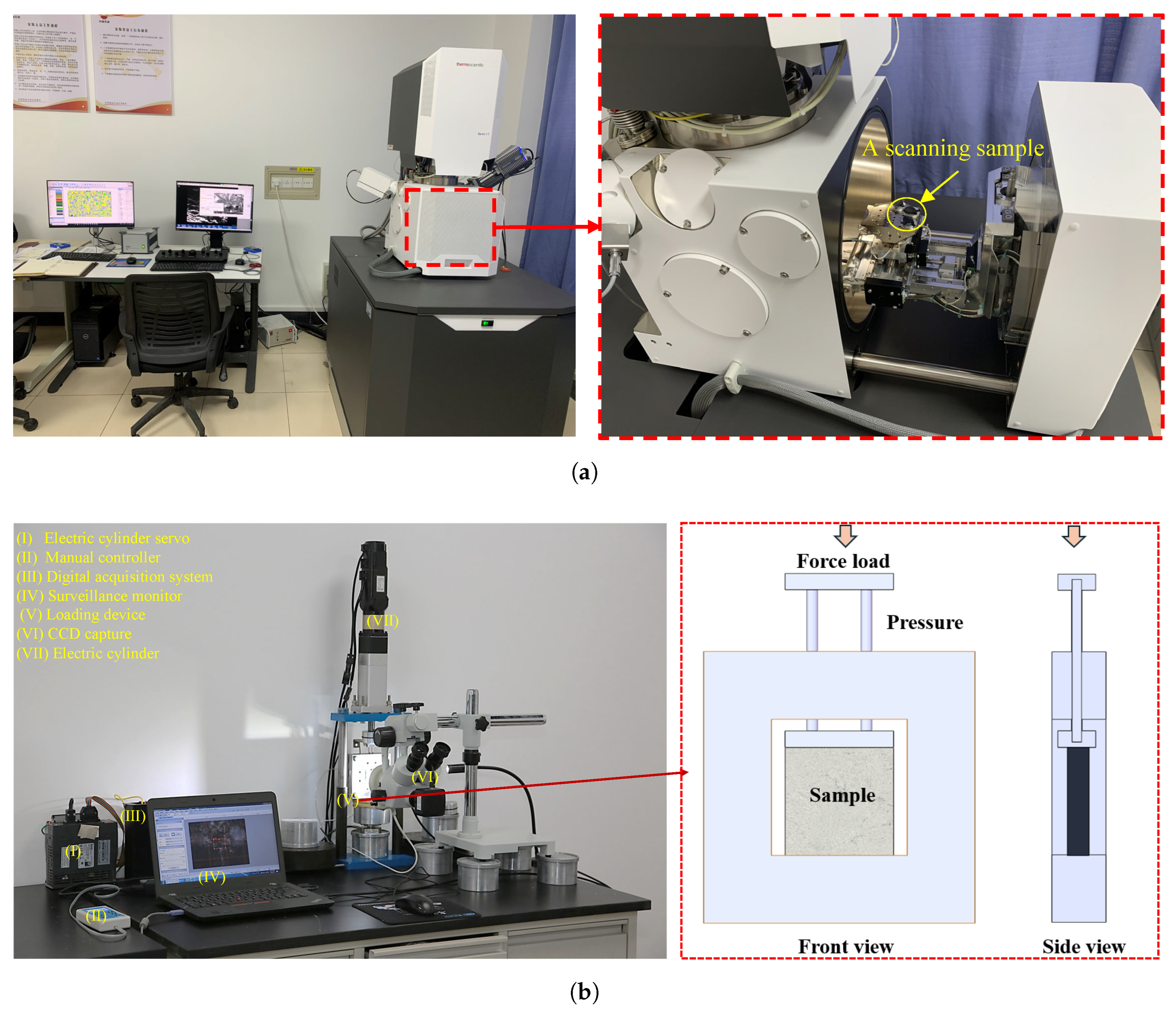


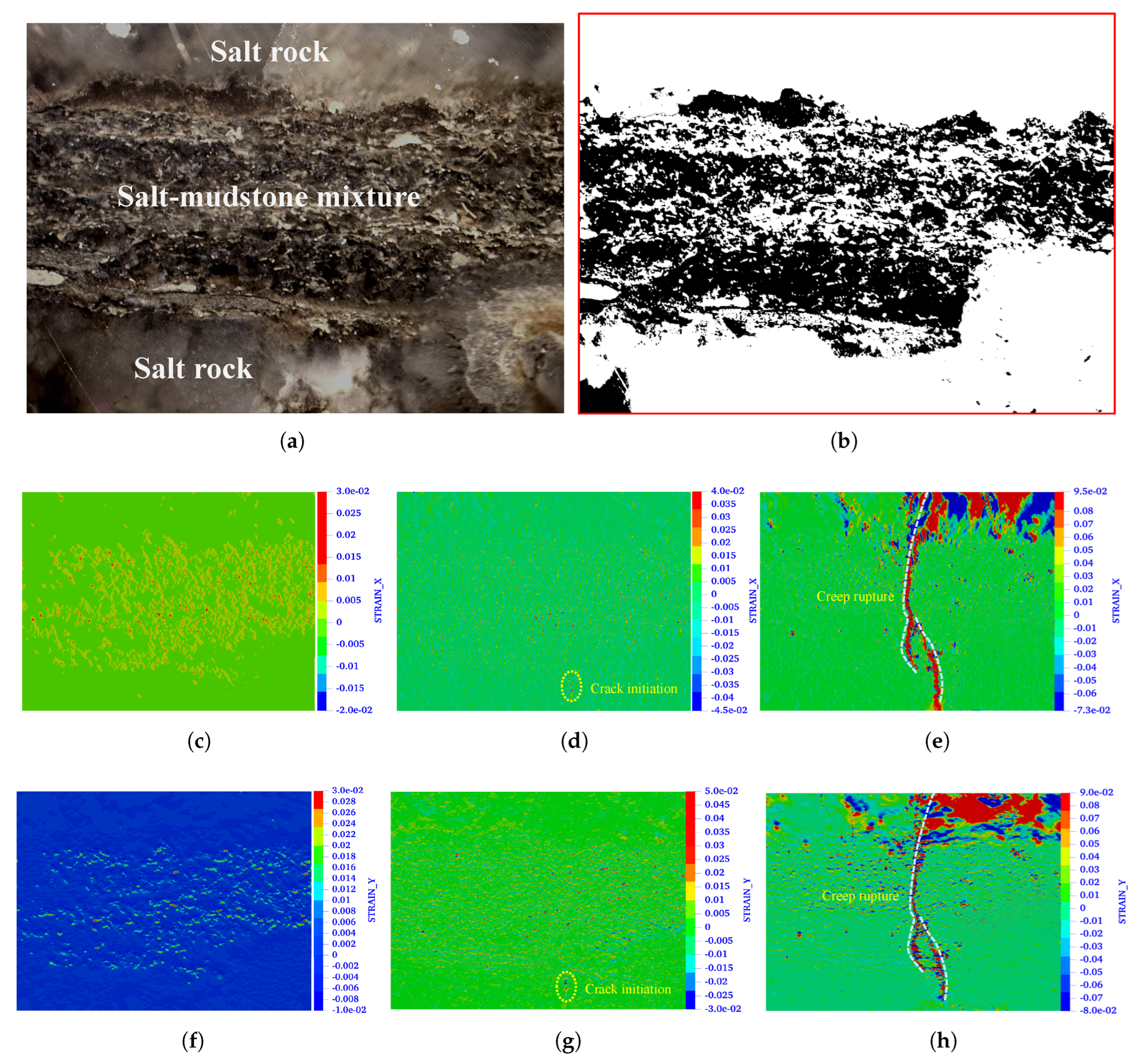
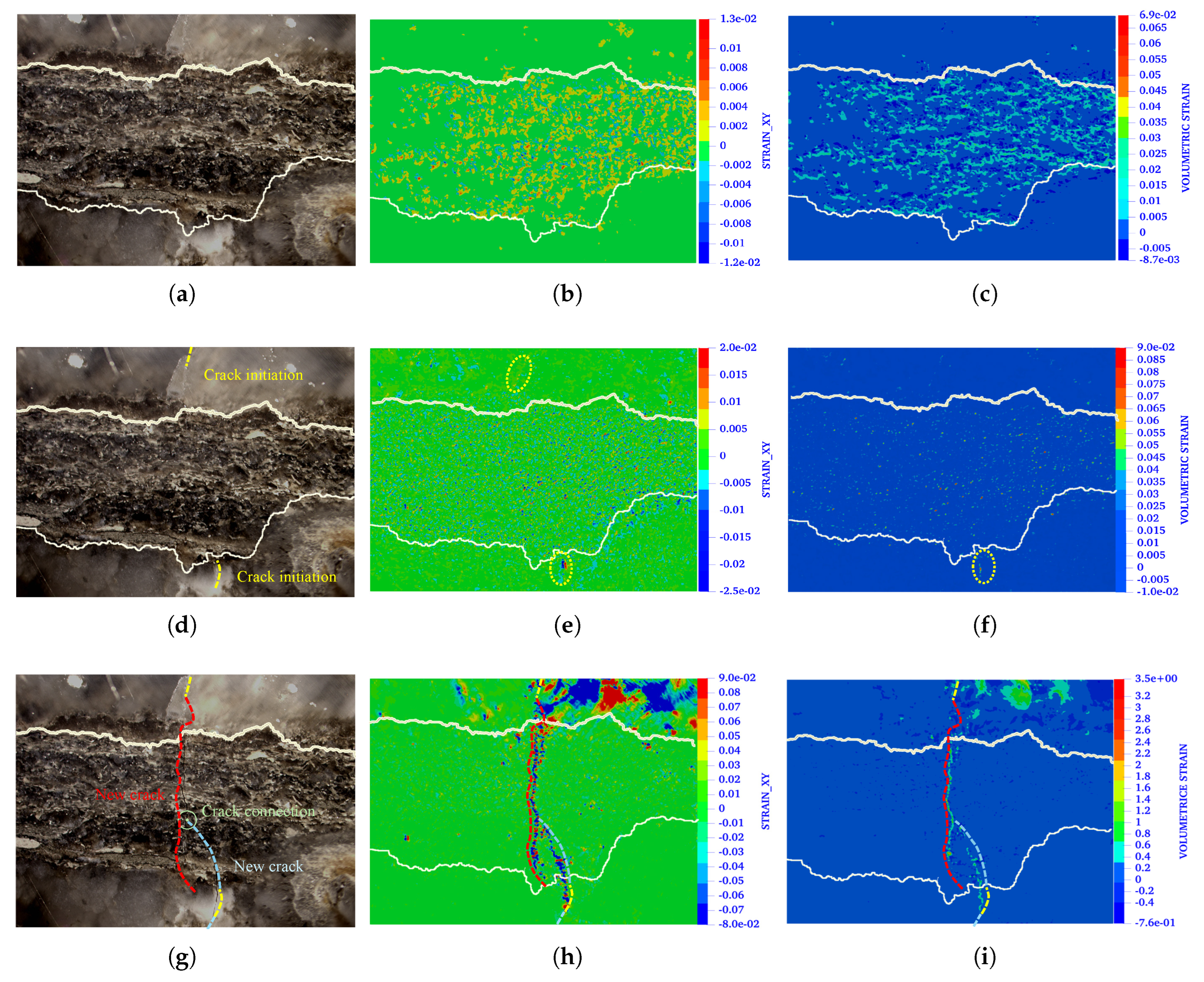

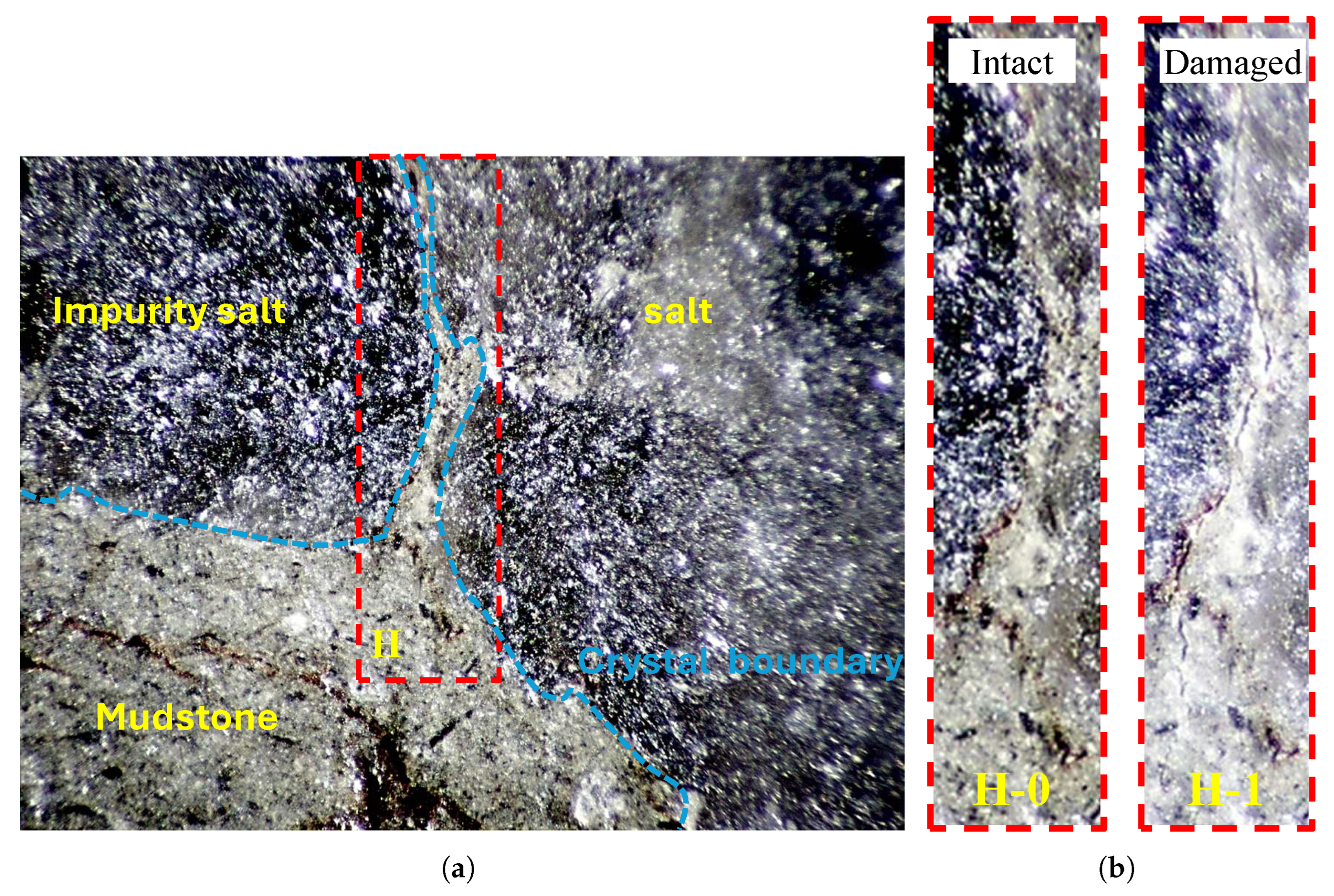
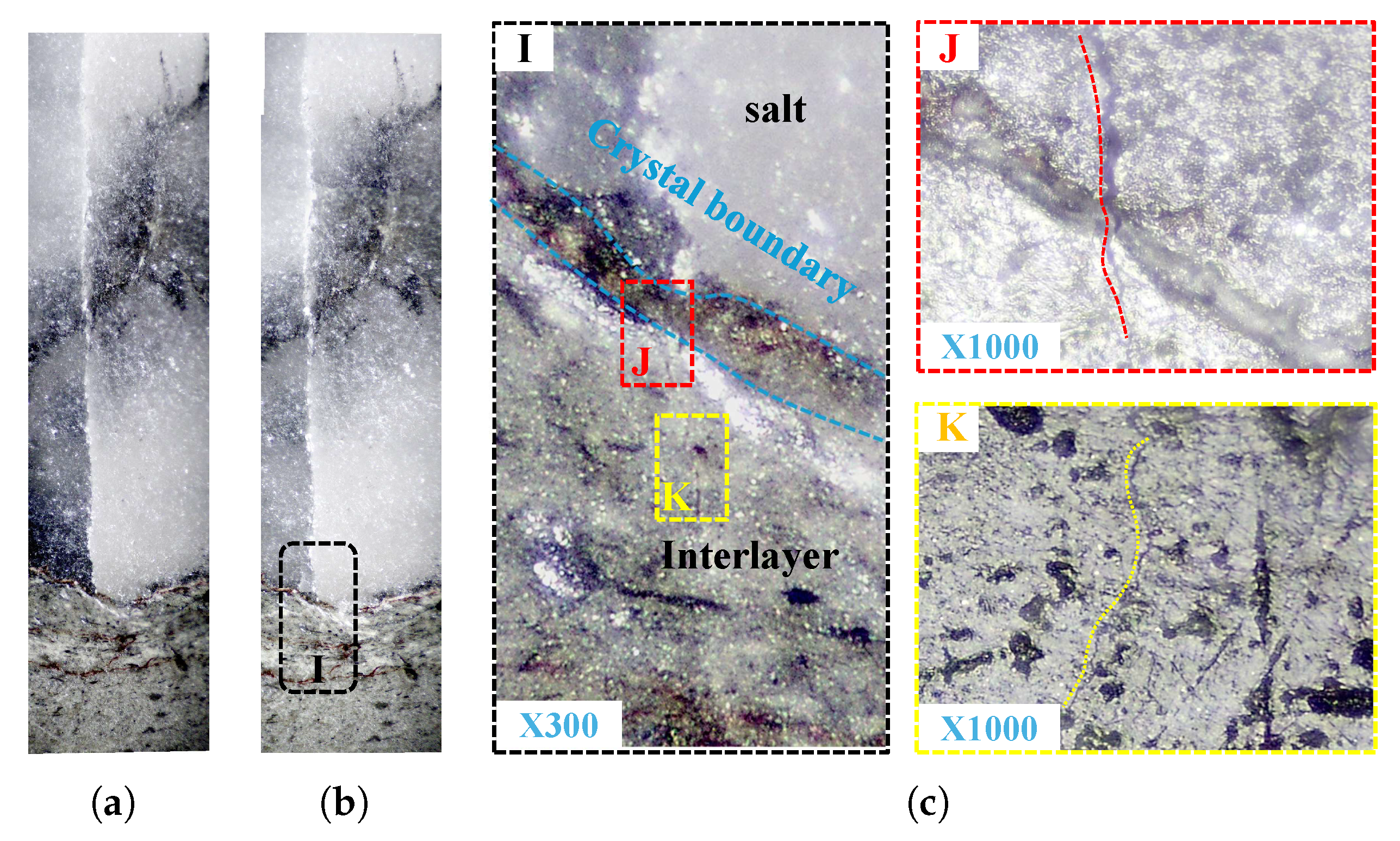
| Atomic Mass (%) | Na | Cl | Mg | AI | Si | Ca | Fe |
|---|---|---|---|---|---|---|---|
| Rock salt | 50.26 | 49.74 | 0 | 0 | 0 | 0 | 0 |
| Mudstone | 1.33 | 0.58 | 0 | 0.15 | 5.54 | 11.94 | 0.97 |
| Salt–mud interface | 29.4 | 24.80 | 1.76 | 1.84 | 4.9 | 3.25 | 1.06 |
Disclaimer/Publisher’s Note: The statements, opinions and data contained in all publications are solely those of the individual author(s) and contributor(s) and not of MDPI and/or the editor(s). MDPI and/or the editor(s) disclaim responsibility for any injury to people or property resulting from any ideas, methods, instructions or products referred to in the content. |
© 2025 by the authors. Licensee MDPI, Basel, Switzerland. This article is an open access article distributed under the terms and conditions of the Creative Commons Attribution (CC BY) license (https://creativecommons.org/licenses/by/4.0/).
Share and Cite
Ren, F.; Yi, H.; Chen, Z.; Zhang, T.; Li, Z.; Zhong, H. Experimental Investigation of the Mesostructural Damage in Bedded Rock Salt During Creep Deformation. Crystals 2025, 15, 305. https://doi.org/10.3390/cryst15040305
Ren F, Yi H, Chen Z, Zhang T, Li Z, Zhong H. Experimental Investigation of the Mesostructural Damage in Bedded Rock Salt During Creep Deformation. Crystals. 2025; 15(4):305. https://doi.org/10.3390/cryst15040305
Chicago/Turabian StyleRen, Fengfei, Haiyang Yi, Zheng Chen, Tianzi Zhang, Ze Li, and Hao Zhong. 2025. "Experimental Investigation of the Mesostructural Damage in Bedded Rock Salt During Creep Deformation" Crystals 15, no. 4: 305. https://doi.org/10.3390/cryst15040305
APA StyleRen, F., Yi, H., Chen, Z., Zhang, T., Li, Z., & Zhong, H. (2025). Experimental Investigation of the Mesostructural Damage in Bedded Rock Salt During Creep Deformation. Crystals, 15(4), 305. https://doi.org/10.3390/cryst15040305






